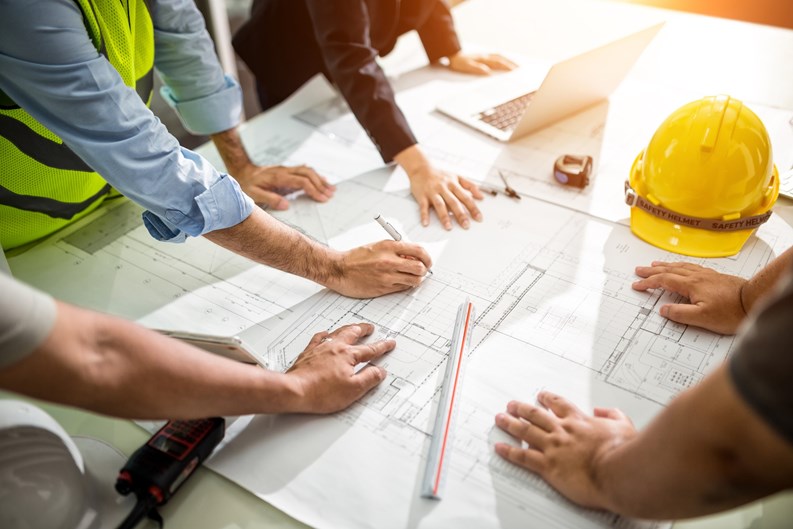Managing a major construction project in a multifamily building requires careful planning and oversight. From securing work areas to ensuring that contractors, residents, property managers, and other stakeholders comply with an array of legal requirements, having detailed protocols in place means everyone can work safely.
No-Go Zones
First off, worksite perimeters must also be established and clearly marked. Jose Vicente Perez, president of JVP Construction Group in South Florida, explains, “The construction area has to be protected, and residents cannot not be allowed to enter. Project managers need to install barricades and cones or a temporary fence to keep residents out of the work area.”
Matt Herceg, senior project manager at Becht Engineering in New York City, agrees that safety must always be the first priority: “The most important part of a building project is having a plan. Safety is everyone’s responsibility.” He adds that “Barriers keep people out of construction zones, and setting up a staging area, a centralized location for materials nearby, is also helpful.”
It’s also vitally important to consider homeowners’ daily activities and access to their homes and common areas when planning major residential projects that could cause disruptions. Clear protocols must be implemented and followed to minimize resident impact and to ensure safety.
Herceg points out that “If you’re going to have workers on a residential site, you should have a system where every worker has to sign in and wear proper identification. This way, residents know who they’re working for; they must be signed in with the team leader and wear proper gear—not only for physical safety, but also so they can easily be identified as someone who’s allowed on site. We ask contractors to submit how many people will be on-site that day, and stress to residents the importance of knowing who is walking around the building. This keeps everyone on the same page.”
Structural Safety
Ensuring structural safety is crucial to the success of any project. “Structural safety is key to ensuring the project runs smoothly and is safe. You need to make sure the building is safe. We recommend involving a consultant or engineer to meet general structural safety needs,” advises Herceg.
Complex projects often involve intricate structural elements, such as shoring, which stabilizes a building during renovations. RAND senior structural engineer Jason Damiano notes that “If you get to the point where shoring is involved—structural shoring requires a separate plan—make sure the structure isn’t compromised. Safety must be emphasized before anything else; if something is unsafe, it needs to be addressed. Make it safe and then continue.”
Becht Engineering principal Russ Fernandes also highlights the importance of having skilled oversight by stating, “Codes also change over time. Railings need to be a certain height, and openings should have a certain allowance on decks, for example. Having a demo plan in place is key. Having an engineer on board can make sure the project is being performed properly. Most contractors prefer that as well.”
Coordination and partnership between stakeholders can mean the difference between smooth operations and careless errors. Fernandes underscores the role of communication, saying, “Effective communication is so important when working on a big project at a multifamily property because capital improvements are collaborative projects; at the end of the day, anyone can simply complete a project, but if you work together with the board management, homeowners, and legal and insurance providers, you can create an efficient process that meets everyone’s needs.”
Vicente Perez stresses maintaining open communication lines during construction. “If anyone notices an unsafe working condition, they should immediately inform the contractor so they can correct the situation,” he says. Herceg shares a practical perspective, stating that “Everyone needs to be observant, so if anything occurs everyone can react appropriately. It’s a common-sense focus that might not be on everyone’s minds, especially if they don’t have extensive construction experience. You always want to make sure you have an opportunity to ask questions and work with the board. A good contractor will also want to do that—and it would be a red flag if they don’t.”
Maintaining Compliance
Incorporating safety standards is critical for the success of any job. “Worker safety is essential. Over the years, we’ve seen an increase in OSHA involvement to help ensure secure work sites,” says Fernandes. “It’s vitally important that contractors follow OSHA protocols designed to protect everyone during a project.”
Vicente Perez warns of the dangers of neglecting basic safety practices: “If workers don’t use the proper PPE (personal protective equipment) or fail to install barricades to keep residents out of the area, for example, the construction zone becomes hazardous for everyone involved.”
Project managers should conduct regular, thorough site inspections to assess existing conditions. “They should walk around the construction area to evaluate safety risks,” advises Vicente Perez. Damiano underscores the importance of compliance with local safety requirements. “In NYC, we have a relatively new Tenant Protection Plan designed to protect tenants during construction or renovation projects. Contractors must submit a comprehensive plan covering egress, fire safety, health requirements, structural safety, noise restrictions, and services—submitted to the Department of Buildings (DOB) before a permit is issued.”
Proper documentation is key to keeping the project on track and up to code. Vicente Perez emphasizes that project managers should require contractors to provide proof of insurance and bonding for every project to avoid liability. Property managers can also verify contractor licenses with the Department of Business Regulation. Damiano adds specifics about NYC regulations: “Contractors must keep insurance on file with the NYC Department of Buildings, which won’t issue a permit unless specific insurance requirements are met.”
To maintain safety throughout the project, Damiano stresses the importance of ongoing inspections: “There is a weekly inspection of the worksite and areas of the building to ensure compliance with the Tenant Protection Plan.” Vicente Perez adds, “Regular safety meetings are also essential to maintain ongoing vigilance.”
Collaboration and commitment by all stakeholders, paired with a well-thought-out plan, ensure peace of mind and a successful, safe project compliant with local laws. High standards and careful execution help everyone involved in multifamily building projects work safely and efficiently.
Kate Mattiace is the Associate Editor of CooperatorNews.







Leave a Comment